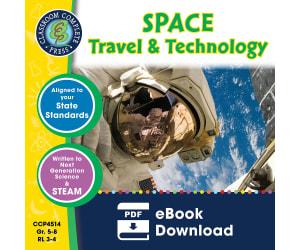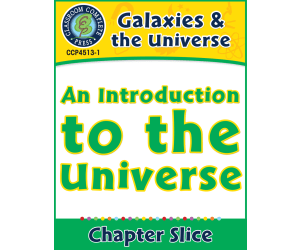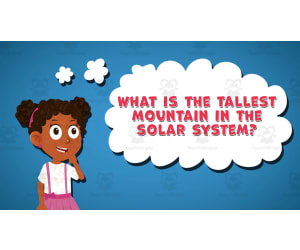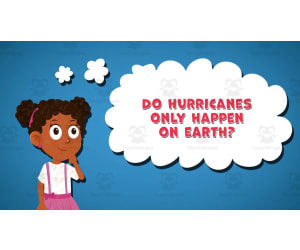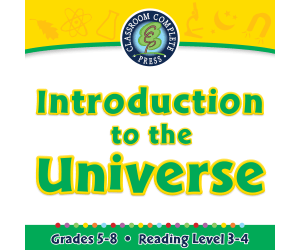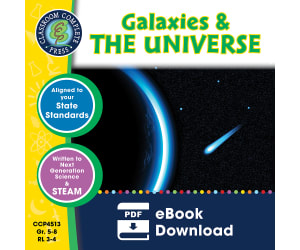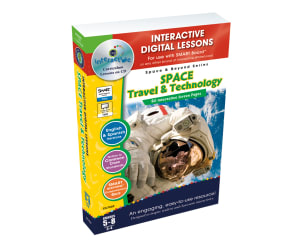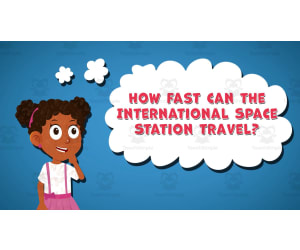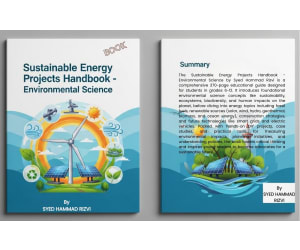2,750 products added recently
Space Lesson Plans
Ignite your students' imagination with lesson plans that delve into astronomy and space exploration. Covering topics from the solar system to deep space phenomena, these resources include engaging activities and multimedia elements. Use them to inspire awe and curiosity about the cosmos.
Drone Data Detectives:Mastering UAVs for Environmental Mapping
Research, Community Building, Resources for Teachers, Science, Earth and Environmental Sciences, Earth Sciences, Environmental Science, Geology, Space, Life Sciences, Grade 2, 3, 4, 5, 9, 10, 11, 12, Activities, Centers, Experiments, Labs, Assessments, Teacher Tools, Graphic Organizers, Lesson Plans, Outlines, Literacy Readers
Get ready for the ultimate in drones and environmental science with "Drone Data Detectives: Mastering UAVs for Environmental Mapping & Climate Monitoring." The comprehensive high school STEM book on drones deepens the knowledge of teens into the world of Unmanned Aerial Vehicles, making them drone pilots, data analysts, and environmental stewards. This key resource covers everything needed to take raw drone data and develop actional insights in support of climate change monitoring, conservation, agriculture, and disaster response-from the basics in drone piloting and safety regulations to planning flights, and from the advanced sensors that capture aerial data, such as thermal imaging and multispectral cameras, to LiDAR. Packed full of real-world missions, ethical considerations, GIS analysis techniques, machine learning applications, and project-based learning, it is a no-brainer for aspiring scientists interested in remote sensing, photogrammetry, vegetation health metrics, and sustainable technology. This is an ideal textbook for grades 9-12 classrooms, great for homeschooling, or self-study, this book aims to fire up the theoretical teaching with practical skills in order to inspire the next generation of eco-innovators. Keywords: drone education for teens, UAV environmental mapping, climate monitoring drones, STEM books high school, data analysis environmental science, drone piloting guide, remote sensing technology, Why Parents/Schools Love It: Hands-On STEM Activities: Blends theoretical concepts with hands-on drone operations, developing critical thinking and real-world problem-solving capabilities, especially in environmental sectors such as climate change and biodiversity. Future Ready Career Preparation: It delves into areas such as conservation using drones, data science, which matches global career requirements in the field of Green Technology, sustainable development, among others. Encourages Environmental Awareness: Emphasizes responsible use of drones and awareness of global issues that encourage teens to play a role in protecting the planet with technology. Thorough and Readily Available: This text consists of 100 chapters perfectly suited for a classroom setting as it covers topics ranging from fundamental to advanced levels. Safe & Responsible Focus: It is more bent on rules, safety, and risk management, offering reassurance for educational UAV operations. Target Audience : After analyzing the content of the book in entirety—right from the introduction about basic components of drones to aerodynamics, followed by intermediate levels of topics such as sensors and data acquisition, advanced topics of machine learning and analysis of space, to practical implementations in conservation and climate observation—the book has been written for students in grades 9-12 (14-18 years of age), aiming at students expressing interest in the science of tech but gradually increasing in content across: For grade 9 and 10 students, one may focus on the fundamental chapters related to the history of drones, its parts, and the basics of piloting a drone. Grade 11/12 students: Engage with advanced topics such as multi-spectral indices, GIS integration, and photogrammetry. Designed for students who are deeply interested in environment/earth science, technology, and data sciences, and for students of STEM streams such as those in robotics and science clubs. Not designed for middle-school students due to technical complexity such as operations in the electromagnetic spectrum and calculations for NDVI, and nor for college students who would be doing research and hence would require research detail. Copyright/Terms of Use : This book is copied and adapted from Syed Hammad Rizvi. This Work/Way is intended Solely for Private Use. Neither the text nor any part of this Work/Way shall be copied, distributed, or sold. This means that no part of this Work/Way shall be placed on the Internet where it could be publicly accessed. If you want to Share it with your fellow teachers, you can buy additional licenses from Teachsimple. Thank you for Using Responsibly. “This product is happily brought to you by Syed Hammad Rizvi”
Author Creative Book Store
Rating
Tags DroneDataDetectives, MasteringUAVs, EnvironmentalMapping, ClimateMonitoring, UAVTechnology, DroneEducation, STEMBooks, HighSchoolSTEM, EnvironmentalScience, DronePiloting
Space Travel & Technology Gr. 5-8
Science, Earth and Environmental Sciences, Space, Grade 5, 6, 7, 8, Teacher Tools, Lesson Plans
Space Travel & Technology Gr. 5-8 An exceptional teaching resource designed for science and astronomy curriculum enhancement aimed at students from Grades 5 through 8. Embark your students on a journey into the cosmos, picturing themselves as astronauts on a mission to the International Space Station (ISS). A comprehensive look at space exploration This hands-on resource provides valuable insights into the various roles in a space shuttle mission. Students get familiarized with powerful instruments like telescopes and their role in studying celestial bodies. Dive headfirst into interstellar missions Gaining invaluable knowledge about how spacecrafts function. Planning a hypothetical mission to Mars; assembling necessary items for the projected 2.5-year journey. Designing an innovative, real-world rover intended for planetary exploration, spurring creativity while fostering problem-solving skills. Lunar Studies and Beyond This educational tool dedicates interesting sections to lunar studies, celebrating humanity's greatest achievements like Apollo 11's moon landing. Moreover, it provides an exciting insight into life aboard the ISS and predictions of how everyday toys would operate in zero gravity! This dynamic teaching aid is adaptable across various classroom activities like group sessions or small cluster projects or even as challenging homework assignments! Tailored according to Next Generation State Standards and Blooms Taxonomy’s educational objectives along with STEAM initiatives ensures top-notch education centered around practical inquiry-based learning experiences. Your classrooms' connection to cosmos – Ignite curiosity, foster problem-solving skills and instill within future scientists a love for space science!! Build your scientific teaching toolkit today! Pedagogical strides beyond traditional textbook curriculum Hands-on experiments that promote experiential learning. Crossword puzzles aiming towards vocabulary building exercises thereby ensuring comprehensive learning and retention. Our PDF format ensures easy implementation and maintenance among educators, irrespective of their technical skills. Add Space Travel & Technology Gr. 5-8 – your key to the cosmos, to your educational resources today!
Author Classroom Complete Press
Tags PDF
Wish Upon a Star: A Cross-Curricular Unit on Stars
Science, Earth and Environmental Sciences, Space, Grade 3, 4, Teacher Tools, Lesson Plans
Wish Upon a Star: A Cross-Curricular Unit on Stars This is an invaluable resource for educators facilitating Grade 3 and 4 students. It offers an engaging way for students to broaden their astronomy knowledge, specifically exploring the fascinating world of stars. Using a multi-disciplinary approach, this educational packet includes: An informative non-fiction article on star formation and characteristics Detailed segments about comets and constellations Content tailored with essential facts in digestible chunks suitable for young learners in these grade levels. The Addition of Interactive Worksheets: Alongside the informational text, seven pages of comprehensive worksheets are included. These ready-to-print exercises reinforce learned concepts through active recall. Each worksheet encourages critical thinking while wrapping teachings in fun-filled learning experiences. A Resource Tailored For Varying Teaching Scenarios: The materials provided offer flexibility for use in different teaching scenarios – from whole class activities to small group studies or autonomous tasks. This resource can be used during classroom lessons or assigned as homework - Ensuring consistent learning enhancement. Hassle-Free Access and Integration: All materials are organized into one easy-to-use PDF file type saving you time on preparation. With its compatibility to existing lesson plans, Wish Upon a Star: A Cross-Curricular Unit on Stars stands as a wonderful addition to social sciences curriculum aiming at inspiring curiosity among potential astronomers.
Author Classroom Complete Press
Tags Stars, Science Lesson, Science Unit, Astronomy, Vocabulary
Free Science Sun, Moon & Earth Vocabulary Interactive Review
Science, Earth and Environmental Sciences, Space, Earth Sciences, Environmental Science, Grade 8, Teacher Tools, Lesson Plans
Sun, Moon N Earth Vocabulary Words to Review and Reinforce Definitions of the 8TH Grade Science Curriculum . Students will learn and practice terms through definitions and characteristics. The engaging activity promotes collaboration and class discussion as students review terms definitions, and more with multiple visuals and learning formats like multiple choice questions, memory games, hang-man, and others. This versatile resource can be used for whole-group instruction, small-group practice, or independent work, just practice the words and then review them by choosing the correct one, it will self-correct you until you choose the correct answer Practice your Vocabulary with this Free Interactive Game Introduce young learners to a variety of visuals with this entertaining digital game. Students will see the names and images of different words and definitions; exercising visual memory and concentration. This self-checking activity can be played independently or as a whole class game projected on a smartboard. The vibrant slideshow stimulates engagement while building construction classification skills. students will build their knowledge of important terms and definitions while having fun playing games. This activity stimulates intelligence, builds concentration, reinforces letter recognition, improves spelling and pronunciation, and engagingly expands vocabulary. It's a perfect supplement for your lesson. Check our shop, material, and products for more interactive construction vocabulary reviews covering other topics like human microbiome, metabolism, and more grade levels in science and Spanish language arts. Download this versatile 28-slide PowerPoint today!
Author ShapeUp-N-Matematicas y Lenguaje
Tags SCIENCE, Scientific Argument, Sun Moon Earrth, Moon, Sun, Earth, Solar System, Yeat, Orbit, Terminator
Space Travel & Technology: A Trip to the Moon Gr. 5-8
Science, Earth and Environmental Sciences, Space, Grade 5, 6, 7, 8, Teacher Tools, Lesson Plans
Space Travel & Technology: A Trip to the Moon Gr. 5-8 A chapter slice from the full lesson plan "Space Travel & Technology." This resource propels students of grades 5 through 8 into the thrilling realms of space in an accessible and engaging format. It ignites wonderment for astronomical phenomena while providing practical knowledge about space travel technology. Main Features: Ideal for whole-class instruction or smaller groups. Allows students to simulate roles ranging from astronauts and scientists to engineers and leaders in a virtual shuttle mission crew bound for the International Space Station (ISS). Paves way forward by linking remarkable space advances with earthly technologies, a significant topic within science curricula. Tailor-made Learning Material: This module simplifies complex jargon into easy-to-grasp language suitable for remedial learners in middle school. It encapsulates immense galactic adventures into bite-sized reading passages ideal for both classroom and individual reading exercises. Enhanced Student Activities: Inspires creative thinking within STEAM (Science, Technology, Engineering Art & Maths) parameters. Focusses on core academic exercising including test prep feature sourced from Bloom's Taxonomy inspired lessons plans. Nurtures foundational skills important across subjects like problem-solving abilities。 Note: The curriculum also includes color mini posters reinforcing learned knowledge visually affirms concepts taught aesthetically appealing ways. Fits All Standards: The module links directly with your state standards enhancing successful educational delivery systems making it adaptable even beyond regular classroom boundaries; it suits secular or homeschool based enlightenment too! Step into the awe-inspiring domain of celestial exploration with Space Travel & Technology: A Trip to the Moon Gr. 5-8.
Author Classroom Complete Press
Tags PDF
Local Climate Action: Data-Driven Solutions for Teen Environmentalists
Earth and Environmental Sciences, Science, Earth Sciences, Environmental Science, Geology, Space, Life Sciences, Biology, Human Body, Nature & Plants, Homeschool Curriculum, Homeschool Templates, Grade 6, 9, 10, 11, 12, Lesson Plans, Teacher Tools, Workbooks, Worksheets & Printables, Centers, Activities, Experiments, Labs, Projects, Presentations
Equip and empower the next generation of climate leaders to act through data, tools, and projects that can be immediately applied in their own backyard. "Local Climate Action: Data-Driven Solutions for Teen Environmentalists" is a game-changing book that will empower high school students from climate observers to data-informed climate activists. This textbook written by Syed Hammad Rizvi connects climate knowledge around the world to practical solutions on a local level. By means of 45 chapters, teens are taught how to: Obtain and interpret local environment data with the help of easily accessible tools and sensors Integrate climate change impacts like urban heat islands, flood zones, or pollution hotspots Learn how to effectively disseminate your findings through the use of graphics, such as charts and Create and deliver youth-led projects on climate change that have tangible implications in the real world. Packed with practical examples, protocols, and ethics for a responsible climate response, this book turns classrooms and communities into living laboratories for climate resilience. It is a textbook and a toolkit that reaches beyond education by providing a means for empowerment and increasing awareness and knowledge for a climate-conscious population. Why Parents & Schools Love It: Practical and application-based: Goes beyond theory and projects that students can implement and have the potential for making a difference in the neighborhood community. This inculcates critical skills in data literacy, scientific inquiry, mapping, presentation, and project management skills which will benefit them in both school as well as in their future lives. Aligns with Curriculum: This can be easily incorporated into the curriculum of environmental science, geography, STEM education, and social studies. Youth Agency Enthusiast: This helps youth exercise leadership, representation, and partnership with the community for their benefit, enhancing their self-confidence. Engaging Youth Publication Lowdown Ethical & Inclusive: Emphasizes responsible data use, community science, & justice for our planet & our communities. Target Audience & Grade Level: Primary Audience: Grades: 9-12 Subjects: Environmental Science, Geography, STEM Education, Civics Education, Data Liter Target group: High school students, Eco-clubs, Project based learning initiatives, Homeschoolers, Climate advocacy groups for youths. Secondary Audience: Educators, Science Teachers, People involved in developing Curriculums. Those interested in Activity-based, ‘ Youth groups, libraries, and community centers running climate action projects. Copyright/Terms of Use This Book is copyrighted by Syed Hammad Rizvi. This material is intended only for personal and single-classroom use. This means you do not have the right to copy, distribute, and sell any part of this material. That is, you cannot place the material on the Internet where it could be downloaded by the public. If you want to share this resource among colleagues in your institution, you would need to purchase additional copies of this product through Teachsimple. Thank you for respecting this usage policy. This product has been shared among you happily by Syed Hammad Rizvi
Author Creative Book Store
Rating
Tags TeenEnvironmentalists, ClimateAction, DataLiteracy, STEMeducation, HighSchoolScience, ProjectBasedLearning, ClimateChangeEducation, YouthLeadership, EnvironmentalScience, TeacherResources
Galaxies & The Universe: An Introduction to the Universe Gr. 5-8
Science, Earth and Environmental Sciences, Space, Grade 5, 6, 7, 8, Teacher Tools, Lesson Plans
Galaxies & The Universe: An Introduction to the Universe Gr. 5-8 An educational resource designed specifically for students grade 5 to 8 covering significant aspects of science and astronomy. This comprehensive guide is aimed at enlightening young minds about the fascinating world of galaxies and our universe. Highlights include: A tour from the smallest matter particles to the grandest star systems present in our universe starting with our own Milky Way Galaxy. Detailed insights into intriguing phenomena such as Black Holes and Gravity. Educational content on Nebulae, diverse light sources, and an indepth study on Speed of Light. Exploration of Quasars, some of the most distant objects known in this infinite universe. Educational Approach: The content utilises simplified language ensuring complex concepts are easily understandable by students. Comprehensive learning is supported with reading passages combined with activities before and after reading. Hands-on activities offer experiential learning opportunities enabling concrete understanding of scientific concepts. Instructional Flexibility: This guide offers flexible implementation options be it full-class teaching sessions, small group instruction arrangements or homework assignments promoting independent work abilities among learners. Achievement Metrics: The guide adheres strictly to State Standards for assured academic integrity. It incorporates Bloom's Taxonomy along with STEM initiatives as guiding principles structuring its curriculum design approach. Incorporate Galaxies & The Universe: An Introduction to The Universe Gr. 5-8 into your educational resources today! This resource is available digitally in PDF format through a single Product File offering versatility & convenience to modern educators & homeschooling parents alike... Invest in knowledge with Galaxies & The Universe: An Introduction to The Universe Gr. 5-8! Jumpstart an enriching journey into space science and unravel the mysteries of the universe through immersive learning experiences!
Author Classroom Complete Press
Tags PDF
Space Travel & Technology - Digital Lesson Plan Gr. 5-8 - FLASH-PC
Science, Earth and Environmental Sciences, Space, Grade 5, 6, 7, 8, Teacher Tools, Lesson Plans
Space Travel & Technology is a comprehensive and interactive digital lesson plan crafted ideally for grades 5 to 8. This unique resource bridges the gap between learning and discovery as students envision themselves as integral members of an exciting shuttle mission to the International Space Station. Coupling knowledge with creativity, this resource positions the student in roles of scientists, engineers, astronauts and leaders. In this highly engaging program that spans over 80 screen pages, learners are guided deeper into theories of space exploration taking them on a cognitive journey through our solar system - from the Moon to Mars and beyond. It underscores not only how our understanding of space has advanced over time but also how it will continue evolving with their contribution. Instructional Content & Activities: Reading Passages: Designed according to Bloom's Taxonomy principles. Gauging Activities: Pre-reading and post-reading activities integrated into each lesson. Diverse Learning Support:Aids such as memory match games, crosswords, word searches included. This program serves as an excellent primary tool for classroom teaching whether it is directed at a whole group or could be subdivided for small group collaborations aiming for more individual-oriented discussions in classrooms or even as robust homework assignments presenting practical application possibilities that resonate real-world situations. Digital Accessibility & Extras Flash PC software format: Makes technology integration effortless without compromising content quality or engagement aspects. Supplementary Video Materials: Extend topic comprehension Text-to-Speech Functions: Available in English and Spanish facilitating ease of understanding amongst varied students' demographics. Rounding up every lesson is an achievable test preparation component designed to evaluate student’s comprehension seamlessly while familiarizing them with testing formats. Adherence to State Standards makes this digital product further trustworthy enabling educators ensure curriculum alignment effortlessly through contemporary teaching avenues reinforcing both - subject matter expertise & modern pedagogical approaches further elevating teaching quality. Space Travel & Technology - Digital Lesson Plan Gr. 5-8 thrives in creating not just lessons, but ambitions on a path towards continual future-bound learning till beyond the limits of our sky.
Author Classroom Complete Press
Tags Software (PC)
Space Space Space Gr. 1-3
Science, Earth and Environmental Sciences, Space, Grade 1, 2, Teacher Tools, Lesson Plans
Space Space Space Gr. 1-3: An Engaging Teaching Resource Space Space Space Gr. 1-3 is designed to simplify and explain the vast mysteries of the Universe to Grade 1, Grade 2 and Grade 3 students. It serves as an excellent introduction to space science and astronomy. Coverage of Wide Range of Topics This comprehensive resource package covers a diverse range of topics which include: The Universe The Solar System The Sun, The Moon, Other Moons Stars, Comets and Constellations. Innovative Learning Tools Included! Task Cards: These encourage independent learning among students by presenting compelling questions about various cosmic concepts. Journal Word Cards: The Journal Word Cards enhance a student's creative writing abilities using new terms related to space science. Hands-On Activities: This feature refines skills in Math & Language Arts by encouraging student engagement within these core subjects through unique astronomical contexts." Fosters Foundation for Advanced Studies & Ease-of-use on Digital Devices! "Space Space Space Gr. 1-3", offers an easy-to-use PDF file format ensuring simple accessibility on most digital devices without sacrificing print quality if hard copies are required. This product lays groundwork for more advanced studies – fostering an appreciation for Earth Science from a young age that can permeate throughout subsequent school years. Versatility in Teaching! This product performs wonderfully during whole group instruction periods or small group activities where individual knowledge gaps could be addressed more meticulously. It comes with an all-inclusive teacher and student section complete with reading passages, activities, word search task cards, a quiz , and an answer key making it an invaluable asset in any Grade 1-3 educator's toolkit.
Author Classroom Complete Press
Tags PDF
I WONDER - Is There Life On Exoplanets | Animated Video Lesson
Space, Earth and Environmental Sciences, Science, Grade 4, 5, 6, 7, 8, 9, 10, Lesson Plans, Teacher Tools
Video Introduction An amazing video designed for the students to learn more about space facts. I WONDER - Is There Life On Exoplanets | Animated Video Lesson Do you like reading about space? If yes, what is your favorite topic? What do you know about our solar system? What is the smallest planet in our solar system? What is the biggest planet in our solar system? What is the hottest planet in our solar system? And what is the coldest one? Do you think there are aliens? If yes, what do you think they look like? What do they eat and how they speak to each other? Where do they live? What is a galaxy? And what is a milky way? Have you recently saw a shooting star? If yes, tell us more about it, like when did it happen and where? What is a blackhole? Can a blackhole gets bigger by time? Do you like counting the stars? What do you think a star is made of? I WONDER - Is There Life On Exoplanets | Animated Video Lesson The video is perfect for encouraging the researching skills for the students, while learning more about the fantastic space. I WONDER - Is There Life On Exoplanets | Animated Video Lesson This friendly designed video is suitable for students at school, homeschooling, and as a group activity. Format Available in MP4 format.
Author Educational Voice
Tags Is There Life On Exoplanets, Is There Life On Exoplanets Video, Exoplanets, Exoplanet, Exoplanets Facts, Exoplanets Facts For Kids, Exoplanets Video, Exoplanets Video For Kids, Space, Space Video For Kids
I WONDER - What Is The Tallest Mountain In The Solar System
Space, Earth and Environmental Sciences, Science, Grade 6, 7, 8, 9, 10, 11, 12, Lesson Plans, Teacher Tools
Video Introduction An amazing video designed for the students to learn more about space facts. I WONDER - What Is The Tallest Mountain In The Solar System | Animated Video Lesson Do you like reading about space? If yes, what is your favorite topic? What do you know about our solar system? What is the smallest planet in our solar system? What is the biggest planet in our solar system? What is the hottest planet in our solar system? And what is the coldest one? Do you think there are aliens? If yes, what do you think they look like? What do they eat and how they speak to each other? Where do they live? What is a galaxy? And what is a milky way? Have you recently saw a shooting star? If yes, tell us more about it, like when did it happen and where? What is a blackhole? Can a blackhole gets bigger by time? Do you like counting the stars? What do you think a star is made of? I WONDER - What Is The Tallest Mountain In The Solar System | Animated Video Lesson The video is perfect for encouraging the researching skills for the students, while learning more about the fantastic space. I WONDER - What Is The Tallest Mountain In The Solar System | Animated Video Lesson This friendly designed video is suitable for students at school, homeschooling, and as a group activity. Format Available in MP4 format.
Author Educational Voice
Tags What Is The Tallest Mountain In The Solar System, What Is The Tallest Mountain In The Solar System Video, Tallest Mountain In The Solar System, Tallest Mountain In The Solar System Video, Tallest Mountain In The Solar System Facts
I WONDER - Do Hurricanes Only Happen On Earth | Animated Video Lesson
Earth Sciences, Earth and Environmental Sciences, Science, Geology, Space, Grade 3, 4, 5, 6, 7, 8, 9, Lesson Plans, Teacher Tools
Video Introduction An amazing video designed for the students to learn more about natural disasters in different countries. I WONDER - Do Hurricanes Only Happen On Earth | Animated Video Lesson Do you like summer days where the sun is shinning and you can see beautiful flowers everywhere or winter days where it is raining or snowing and where you can set by the fireplace and enjoy the scene from outside your windows? How to do you thing the blizzards and hurricanes or tornadoes got their names? Can you name a volcanic mountain? Have you ever read about earthquakes? Do you know why earthquakes happen? I WONDER - Do Hurricanes Only Happen On Earth | Animated Video Lesson The video is perfect for encouraging the researching skills for the students, while learning more about this fantastic phenomenon. I WONDER - Do Hurricanes Only Happen On Earth | Animated Video Lesson This friendly designed video is suitable for students at school, homeschooling, and as a group activity. Format Available in MP4 format.
Author Educational Voice
Rating
Tags Do Hurricanes Only Happen On Earth, Hurricanes, Hurricane, Hurricanes Facts, Hurricanes Video, Hurricanes Video For Kids, Hurricanes Facts For Kids, Hurricanes On Planets, Hurricanes On Other Planets
I WONDER - Where Have Space Probes Travelled | Animated Video Lesson
Space, Earth and Environmental Sciences, Science, Grade 6, 7, 8, 9, 10, 11, 12, Lesson Plans, Teacher Tools
Video Introduction An amazing video designed for the students to learn more about space facts. I WONDER - Where Have Space Probes Travelled | Animated Video Lesson Do you like reading about space? If yes, what is your favorite topic? What do you know about our solar system? What is the smallest planet in our solar system? What is the biggest planet in our solar system? What is the hottest planet in our solar system? And what is the coldest one? Do you think there are aliens? If yes, what do you think they look like? What do they eat and how they speak to each other? Where do they live? What is a galaxy? And what is a milky way? Have you recently saw a shooting star? If yes, tell us more about it, like when did it happen and where? What is a blackhole? Can a blackhole gets bigger by time? Do you like counting the stars? What do you think a star is made of? I WONDER - Where Have Space Probes Travelled | Animated Video Lesson The video is perfect for encouraging the researching skills for the students, while learning more about the fantastic space. I WONDER - Where Have Space Probes Travelled | Animated Video Lesson This friendly designed video is suitable for students at school, homeschooling, and as a group activity. Format Available in MP4 format.
Author Educational Voice
Tags Where Have Space Probes Travelled, Where Have Space Probes Travelled Video, Space Probes, Space Probe, Space Probes Facts, Space Probes Facts For Kids, Space Probes Video, Space Probes Video For Kids
Galaxies & The Universe: Introduction to the Universe - FLASH-PC
Science, Earth and Environmental Sciences, Space, Common Core, Grade 5, 6, 7, 8, Teacher Tools, Lesson Plans
Galaxies and the Universe: Introduction to the Universe - FLASH-PC An essential teaching resource designed to simplify complex astronomy concepts for Grade 5 through Grade 8 students. It's compatible with PC software and aims at creating a comprehensive, interactive environment that fosters curiosity about cosmic entities. Tailored Educational Content This educational content is geared towards introducing students to the colossal expanse of galaxies and universe. The materials are Informed by Common Core State Standards, guaranteeing they meet designated learning outcomes. Follows Bloom's Taxonomy, which promotes varied levels of thinking skills among students. Robust Reading Passages With Galaxies & The Universe: Introduction to the Universe FLASH-PC, educators receive robust reading passages that have been carefully crafted for optimum comprehension. This approach ensures students grasp core concepts while stimulating a deep interest in studying astronomy. Also included are 'before you read' and 'after you read' questions with each passage. Sterling Features Incorporated: Appealing printables and vocabulary flash cards – promoting hands-on involvement while expanding scientific terminologies. An integration of audio-video components along with interactive activities offers immersive experiences solidifying comprehension through visualizations combined with auditory reinforcements. Apt For Various Settings: Equally suited to both public-school teachers as well as homeschoolers alike. Whether implemented in whole group classes or smaller study circles or even assigned as out-of-class assignments. In summary, the "Galaxies & The Universe: Introduction to the Universe FLASH-PC" emerges as an effective tool responding adeptly to evolving instructional methods within educational landscapes today. It provides a streamlined blend of theory information supplemented by not just active but interactive learning tools fostering holistic student growth within astronomical sciences.
Author Classroom Complete Press
Tags Software (PC)
I WONDER - How Fast Can The Milky Way Move | Animated Video Lesson
Space, Earth and Environmental Sciences, Science, Grade 6, 7, 8, 9, 10, 11, 12, Lesson Plans, Teacher Tools
Video Introduction An amazing video designed for the students to learn more about space facts. I WONDER - How Fast Can The Milky Way Move | Animated Video Lesson Do you like reading about space? If yes, what is your favorite topic? What do you know about our solar system? What is the smallest planet in our solar system? What is the biggest planet in our solar system? What is the hottest planet in our solar system? And what is the coldest one? Do you think there are aliens? If yes, what do you think they look like? What do they eat and how they speak to each other? Where do they live? What is a galaxy? And what is a milky way? Have you recently saw a shooting star? If yes, tell us more about it, like when did it happen and where? What is a blackhole? Can a blackhole gets bigger by time? Do you like counting the stars? What do you think a star is made of? I WONDER - How Fast Can The Milky Way Move | Animated Video Lesson The video is perfect for encouraging the researching skills for the students, while learning more about the fantastic space. I WONDER - How Fast Can The Milky Way Move | Animated Video Lesson This friendly designed video is suitable for students at school, homeschooling, and as a group activity. Format Available in MP4 format.
Author Educational Voice
Tags How Fast Can The Milky Way Move, How Fast Can The Milky Way Move Video, Milky Way, Milky Way Facts, Milky Way Facts For Kids, Milky Way Video, Milky Way Video For Kids, Space, Space Video
Galaxies & The Universe Gr. 5-8
Science, Earth and Environmental Sciences, Space, Grade 5, 6, 7, 8, Teacher Tools, Lesson Plans
Galaxies & The Universe Gr. 5-8 is an engaging and educational tool designed to enhance your students' understanding of space and our immense universe. Targeted towards grades 5 to 8, this valuable teaching aid deeply explores essential astronomy topics such as the formation of the Milky Way galaxy, distance measurement in light years, specifics about various galaxies to quasars. Embracing science within young minds, it elaborates on exciting aspects like investigating the Big Bang theory and understanding nebulae constructions. Teachers will find value in these lessons that spur active learning; students can fabricate their own nebula using everyday materials like construction paper, newspaper, and water. An additional activity includes constructing pinhole models representing four distinct types of galaxies—barred, elliptical, spiral and irregular—that foster active engagement while absorbing relevant aspects related to universal events. The lesson takes a measurable turn by venturing into real-world applications; kids learn how weight differs on different celestial bodies, such as the sun or other planets. This feature underscores gravity's role in planetary orbits—an indispensable part that links everyday physics concepts with expansive cosmic narratives. The intrigue escalates with a section devoted entirely to black holes - one of space's most mysterious phenomena. As part of this all-inclusive study module students gain a chance not only understand black hole phenomena but also engage creatively by drafting their own unique science fiction story centered around them . This holistic interdisciplinary approach aligns perfectly with Next Generation State Standards besides being crafted following Bloom's Taxonomy and STEAM initiatives ensures effortless integration during classroom instruction be it group discussion or focused study circles. It includes crossword puzzles, word searches along with comprehension quizzes heightens its interactive appeal while providing an effective academic reinforcement tool for teachers or homeschoolers alike. The inclusion of multiple file formats provides tech-friendly versatility making it easily adaptable across various teaching settings. An answer key enhances its practical utility serving as a time-effective tool for teachers or homeschoolers during evaluations. To summarize, Galaxies & The Universe Gr. 5-8 offers an unparalleled pedagogical journey by merging theoretical aspects with imagination and creativity to provide a cosmic world of learning within your classrooms!
Author Classroom Complete Press
Tags PDF
All About Space | Five Facts Video Lesson
Science, Earth and Environmental Sciences, Space, Not Grade Specific, Lesson Plans, Teacher Tools
This animated video lesson will give you five facts all about space. Students will love this engaging and interactive video. This video serves as a great introduction or review video for your learners. This is a 3-minute video lesson.
Author Educational Voice
Tags Science Lesson, Science Video, Outer Space, Astronomy, Solar System
Space Travel & Technology - Digital Lesson Plan Gr. 5-8 | MAC Software
Science, Earth and Environmental Sciences, Space, Grade 5, 6, 7, 8, Teacher Tools, Lesson Plans
Space Travel & Technology - Digital Lesson Plan Gr. 5-8 | MAC Software Embark on an interstellar educational journey with your students using the Space Travel & Technology Digital Lesson Plan for grades 5 to 8. This comprehensive teaching resource is designed to stimulate imaginations and harness a future-focused mindset, with a central theme of a shuttle mission to the International Space Station. The highly interactive software offers eighty screen-pages packed with intriguing information and engrossing activities that will help students envisage themselves as scientists, engineers, astronauts or leaders in the field of space exploration. The lessons envision mankind's expeditions back to Moon and onwards to Mars while also prepping today's generation for those looming space adventures. Key Features: An abundant reading passages followed by interactive tasks such as before-and-after comprehension questionnaires, test preparations, memory match games among others. Crossword puzzles, word search activities along with printable pages promoting active student participation throughout the learning process. Videos that consolidate anticipated learning outcomes from each session. Multicultural inclusion via English and Spanish Text-To-Speech options enhancing language skills while learning science. This MAC compatible teaching software (delivered as one zip file) ensures thorough understanding of every unit learned within this interactive digital module by integrating a Comprehension Quiz at end of each lesson. This aligns perfectly with State Standards following Bloom's Taxonomy formulae for pedagogical success. The digital lesson plan can be utilized completely by itself or complement existing curricula either in group classes or individual assignments scenarios depending upon educators choice making Astronomy classes distinctively fascinating for both homeschooling or conventional school settings environments
Author Classroom Complete Press
Tags Digital Lesson Plan, Science Reading Passage, Astronomy Lesson, Space Travel, Technology Activity
I WONDER - How Heavy Is Saturn | Animated Video Lesson
Space, Earth and Environmental Sciences, Science, Grade 3, 4, 5, 6, 7, 8, 9, Lesson Plans, Teacher Tools
Video Introduction An amazing video designed for the students to learn more about space facts. I WONDER - How Heavy Is Saturn | Animated Video Lesson Have you ever thought about travelling to space?! Join us with this amazing video about Saturn. Do you think we can visit Saturn some day? How amazing is space! Let's discover some amazing facts about planets, asteroids, our solar system and the milky way! Do you know that we have two kinds of planets in our solar system? Can you name the planets based upon their core type? I WONDER - How Heavy Is Saturn | Animated Video Lesson The video is perfect for encouraging the researching skills for the students, while learning more about the fantastic space. I WONDER - How Heavy Is Saturn | Animated Video Lesson This friendly designed video is suitable for students at school, homeschooling, and as a group activity. Format Available in MP4 format.
Author Educational Voice
Rating
Tags How Heavy Is Saturn, Saturn, Saturn Facts For Kids, Saturn Video, Saturn Facts, Saturn Video For Kids, Space, Space Facts, Space Facts For Kids, Space Video
I WONDER - Can We See Uranus From Earth | Animated Video Lesson
Space, Earth and Environmental Sciences, Science, Grade 4, 5, 6, 7, 8, 9, 10, Lesson Plans, Teacher Tools
Video Introduction An amazing video designed for the students to learn more about space facts. I WONDER - Can We See Uranus From Earth | Animated Video Lesson Do you like reading about space? If yes, what is your favorite topic? What do you know about our solar system? What is the smallest planet in our solar system? What is the biggest planet in our solar system? What is the hottest planet in our solar system? And what is the coldest one? Do you think there are aliens? If yes, what do you think they look like? What do they eat and how they speak to each other? Where do they live? What is a galaxy? And what is a milky way? Have you recently saw a shooting star? If yes, tell us more about it, like when did it happen and where? What is a blackhole? Can a blackhole gets bigger by time? Do you like counting the stars? What do you think a star is made of? I WONDER - Can We See Uranus From Earth | Animated Video Lesson The video is perfect for encouraging the researching skills for the students, while learning more about the fantastic space. I WONDER - Can We See Uranus From Earth | Animated Video Lesson This friendly designed video is suitable for students at school, homeschooling, and as a group activity. Format Available in MP4 format.
Author Educational Voice
Tags Can We See Uranus From Earth, Can We See Uranus From Earth Video, Uranus, Uranus Facts, Uranus Facts For Kids, Uranus Video, Uranus Video For Kids, Space, Space Facts, Space Video For Kids
I WONDER - How Fast Can The International Space Station Travel
Space, Earth and Environmental Sciences, Science, Grade 6, 7, 8, 9, 10, 11, 12, Lesson Plans, Teacher Tools
Video Introduction An amazing video designed for the students to learn more about space facts. I WONDER - How Fast Can The International Space Station Travel | Animated Video Lesson Do you like reading about space? If yes, what is your favorite topic? What do you know about our solar system? What is the smallest planet in our solar system? What is the biggest planet in our solar system? What is the hottest planet in our solar system? And what is the coldest one? Do you think there are aliens? If yes, what do you think they look like? What do they eat and how they speak to each other? Where do they live? What is a galaxy? And what is a milky way? Have you recently saw a shooting star? If yes, tell us more about it, like when did it happen and where? What is a blackhole? Can a blackhole gets bigger by time? Do you like counting the stars? What do you think a star is made of? I WONDER - How Fast Can The International Space Station Travel | Animated Video Lesson The video is perfect for encouraging the researching skills for the students, while learning more about the fantastic space. I WONDER - How Fast Can The International Space Station Travel | Animated Video Lesson This friendly designed video is suitable for students at school, homeschooling, and as a group activity. Format Available in MP4 format.
Author Educational Voice
Tags How Fast Can The International Space Station Travel, How Fast Can The International Space Station Travel Video, International Space Station, International Space Station Facts, International Space Station Video, International Space Station Facts For Kids
I WONDER - Can Earthquakes Only Happen On Earth | Animated Video
Earth Sciences, Earth and Environmental Sciences, Science, Geology, Space, Grade 3, 4, 5, 6, 7, 8, 9, Lesson Plans, Teacher Tools
Video Introduction An amazing video designed for the students to learn more about natural disasters in different countries. I WONDER - Can Earthquakes Only Happen On Earth | Animated Video Lesson Do you like summer days where the sun is shinning and you can see beautiful flowers everywhere or winter days where it is raining or snowing and where you can set by the fireplace and enjoy the scene from outside your windows? How to do you thing the blizzards and hurricanes or tornadoes got their names? Can you name a volcanic mountain? Have you ever read about earthquakes? Do you know why earthquakes happen? I WONDER - Can Earthquakes Only Happen On Earth | Animated Video Lesson The video is perfect for encouraging the researching skills for the students, while learning more about this fantastic phenomenon. I WONDER - Can Earthquakes Only Happen On Earth | Animated Video Lesson This friendly designed video is suitable for students at school, homeschooling, and as a group activity. Format Available in MP4 format.
Author Educational Voice
Rating
Tags Can Earthquakes Only Happen On Earth, Earthquakes, Earthquake, Earthquakes Facts, Earthquakes Video, Earthquakes Video For Kids, Earthquakes Facts For Kids, Earthquakes On Planets, Space
I WONDER - Can We Live Without The Sun | Animated Video Lesson
Space, Earth and Environmental Sciences, Science, Earth Sciences, Grade 6, 7, 8, 9, 10, 11, 12, Lesson Plans, Teacher Tools
Video Introduction An amazing video designed for the students to learn more about space facts. I WONDER - Can We Live Without The Sun | Animated Video Lesson Do you like reading about space? If yes, what is your favorite topic? What do you know about our solar system? What is the smallest planet in our solar system? What is the biggest planet in our solar system? What is the hottest planet in our solar system? And what is the coldest one? Do you think there are aliens? If yes, what do you think they look like? What do they eat and how they speak to each other? Where do they live? What is a galaxy? And what is a milky way? Have you recently saw a shooting star? If yes, tell us more about it, like when did it happen and where? What is a blackhole? Can a blackhole gets bigger by time? Do you like counting the stars? What do you think a star is made of? I WONDER - Can We Live Without The Sun | Animated Video Lesson The video is perfect for encouraging the researching skills for the students, while learning more about the fantastic space. I WONDER - Can We Live Without The Sun | Animated Video Lesson This friendly designed video is suitable for students at school, homeschooling, and as a group activity. Format Available in MP4 format.
Author Educational Voice
Tags Can We Live Without The Sun, Can We Live Without The Sun Video, The Sun, The Sun Facts, The Sun Facts For Kids, The Sun Video, Sun, Earth, Sun Facts, Sun Video
Sustainable Energy Projects Handbook - Environmental Science Book
Earth and Environmental Sciences, Science, Earth Sciences, Environmental Science, Geology, Space, Life Sciences, Human Body, Nature & Plants, Physics, Grade 6, 7, 8, 9, 10, 11, 12, Experiments, Activities, Projects, Lesson Plans, Teacher Tools, Workbooks, Worksheets & Printables
Explore the realm of environmental science and sustainable energies with the “Sustainable Energy Projects Handbook - Environmental Science” authored by Syed Hammad Rizvi - an essential handbook that must be present in every school library or educational institution offering environmental science courses for middle school and high school students interested in renewable energies and environmental conservation. This comprehensive 370-page handbook specifically written with grades 6-12 in mind addresses tough subject matters related to ecosystems, natural resources, water & carbon cycle processes, biodiversity conservation, fossil fuels effects, and developing contemporary renewable sources of solar photovoltaics, wind turbines, hydroelectricity, geothermal power, biomass biofuels, and ocean tidal power. Jam-packed with do-it-yourself projects (including solar oven designs & DIY models of wind turbines), case studies of successful community sustainable initiatives all over the world, as well as useful guides in project planning & budgeting analysis, risk assessment & management, product life cycle assessment & carbon footprint calculations, & methods of air & water pollutants control strategies included in this handbook encourage critical thinking & environmental education. It is STEM & SDGs compatible & suitable for teachers or parents looking for hands-on environmental science & sustainable education projects. Keywords: environmental science middle school textbook, sustainable energy projects for middle school students, renewable energy resource for teenagers, climate change lesson plans grades 6-12, environmental education book on STEM and environment, biodiversity and conservation guide, homemade solar wind hydro energy projects for kids, energy conservation education resource, eco-friendly ideas for a science project, environmental energy advocacy for a high school. Why Parents/Schools Love It : Comprehensive and Curriculum-Aligned: It encompasses a broad array of environmental science-related subjects from basic to advanced level projects, aligning perfectly and facilitating a complete understanding of sustainability and renewable energy. Hands-on Learning Activities: It includes various DIY and case studies that help students take part in hands-on learning by making difficult concepts such as solar and wind power more interesting and accessible to them. Fosters Environmental Responsibility: Equips young learners with knowledge about climate change, biodiversity, and values for preparing environmentally responsible global citizens for the future. Engaging and Accessible Language: Presented in clear, technical writing style that appeals to teens, with cross-discipline knowledge from biology, physics, as well as ethics. Adaptive to Various Settings: Designed to fit a multitude of settings, including educational use in the classroom, homeschooling, science fairs, or even clubs, offering tools for measuring the impact of the project. Target Students/Classes : On the basis of a comprehensive assessment of the material, structure, and language of the book, which varies from the basic notions of sustainability, ecosystems, energy fundamentals, renewables, and reaches its climax with the advanced notions of project development, assessment of the environmental implications of such projects (LCA, footprints, etc.), policies, to action, the intended recipients of the material’s scope and focus can be determined to be students between the ages of 11-18, i.e. from grades 6 to 12. Grades 6-8 (Middle School): Best for introductory classes for environmental science, basic cycles, human effects, biodiversity, and simple energy principles, with the goal of creating engagement through DIY projects. Grades 9-12 (High School): More suited for advanced classes in environmental science, earth science, or AP environmental science, focusing on renewable technologies, integration, feasibility analysis, risk analysis, and goals for sustainability in more real-world examples and discussions. Again, this would correlate with the intended audience of grades 6-12 and the progressive level of complexity from the book. Copyright/Terms of Use : This book has been copyrighted by Syed Hammad Rizvi. This educational resource may be used for personal and single class use. You may not, under any circumstances, reproduce, distribute, and sell any part of this resource. This means you may not post this resource on the Internet so it could be downloaded from anywhere. If you would like to share this resource with others, you can purchase more licenses through Teachsimple. Thank you for following the guidelines for use! It is all happily offered by Syed Hammad Rizvi
Author Creative Book Store
Rating
Tags SustainableEnergy, EnvironmentalScience, RenewableEnergy, SolarEnergy, WindEnergy, HydroPower, GeothermalEnergy, BiomassEnergy, OceanEnergy, ClimateChange



